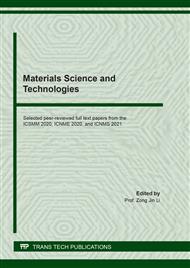p.3
p.10
p.17
p.23
p.31
p.37
p.43
p.49
Damage Behavior in Simulated Service Environment of Thermal Control Oxidation Film of 2A12 Alloy
Abstract:
In order to obtain the service performance of the black anodic oxidation film of 2A12 aluminum alloy, the influence of humidity and temperature in storage environment and heat on the performance of black oxidation film were studied. And the morphologies were analyzed by using optical microscopy (OM) and scanning electron microscopy (SEM). The results showed that after the black anodic oxidation film is produced, "aging" will occur in the natural environment, which can lead to the structure change of the sealing pore and affect the service performance of the film. The film exfoliates off slightly under the humidity of 90%, and the film exfoliates off more seriously when the humidity over 95%. The temperature has a greater influence on the film cracking, especially when the temperature is above 120°C, it is easy to exfoliate off. The exfoliation model was established and the affection mechanism was discussed.
Info:
Periodical:
Pages:
23-28
Citation:
Online since:
July 2021
Authors:
Price:
Сopyright:
© 2021 Trans Tech Publications Ltd. All Rights Reserved
Share:
Citation:


